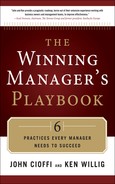Team Resourcing Ground Rules
- The person responsible for the problem activity facilitates the Team Resourcing.
- The Facilitator chooses a timekeeper and chooses the time to be allotted (for example, “I need 10 minutes for Team Resourcing for this issue”).
- The Facilitator defines the apparent problem and gives the background and facts.
- The Facilitator then asks “What’s the goal?,” which the group helps answer.
- The Facilitator asks someone to record all the suggestions that will be made.
- Everyone agrees to be open to all suggestions—no ideas are rejected.
- The Facilitator then asks the group for ideas on how the goal can be attained.
- The Facilitator encourages balanced participation, with no negative editorializing allowed and no discussions, only succinct suggestions.
- The Facilitator creates corrective actions to be taken after the Team Resourcing is completed.
There are two very important attributes to Team Resourcing. We think that they are the real reasons for the success of this tool.
First, we distinguish clearly between the apparent problem and the goal, because it’s too easy to solve an immediate problem and still not accomplish the goal. For example, low productivity is Doug’s apparent problem. But it may be that the goal is not just to push for project-specific productivity, but to build a crew that is loyal and dedicated and will provide high productivity for every job in the long term. And this goal likely will provoke a different set of suggestions and action steps than attempting to solve Doug’s immediate problem.
Second, everyone is encouraged to participate, because everyone is smarter than one person. So, the rules are quite strict about not allowing strongly opinionated folks to squelch the flow of ideas. When the exercise is underway, everyone just calls out their ideas of what might help to accomplish the goals. The scribe writes down the ideas for all to see, and no one is allowed to provide negative comments about anyone’s ideas, as absurd as they may sound at the time. Nor is anyone allowed to start a discussion, lecture, or debate. It’s just a rapid-fire series of suggestions from everyone involved.
This is done so that everyone will contribute and because even seemingly-absurd ideas sometimes can be directly useful or can cause others to think of something that is valuable. It’s this “hitchhiking” of ideas that often gives Team Resourcing its real power.
When completed successfully, Team Resourcing provides the Facilitator with new ideas, that is, new resources. But this is not a democratic exercise; the issue isn’t settled with a popular vote. The person who called for the Team Resourcing exercise, the person empowered to be responsible and accountable for his department and his actions, is free to choose among the new resources to create successful action plans. The decision is his.
